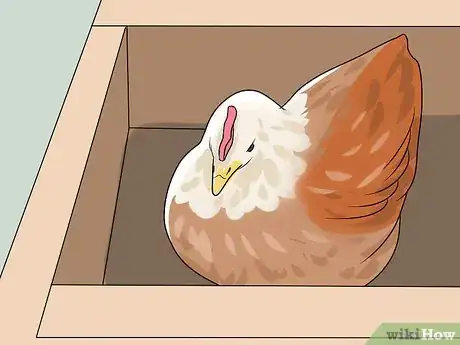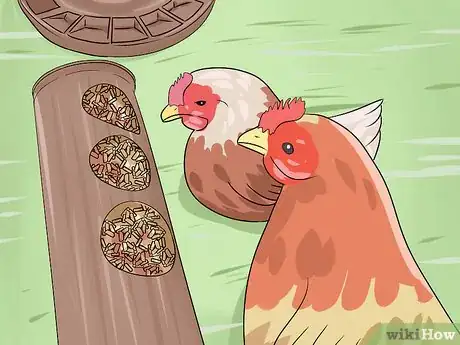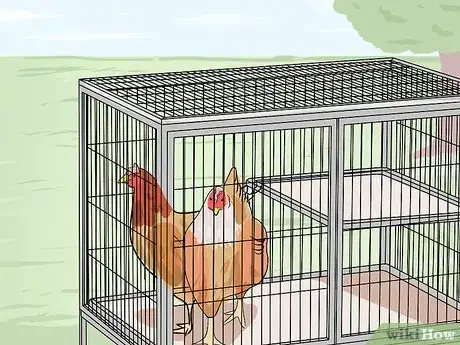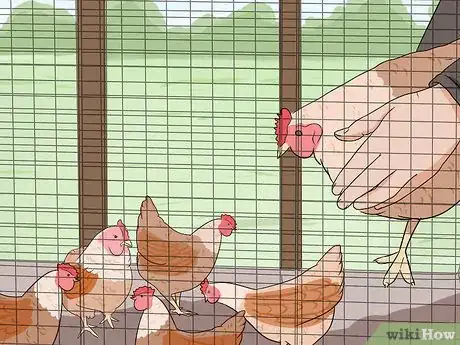This article was co-authored by wikiHow staff writer, Hunter Rising. Hunter Rising is a wikiHow Staff Writer based in Los Angeles. He has more than three years of experience writing for and working with wikiHow. Hunter holds a BFA in Entertainment Design from the University of Wisconsin - Stout and a Minor in English Writing.
This article has been viewed 94,083 times.
Learn more...
Over time, you may need to replace chickens in your existing flock that you lost due to predators, disease, or old age. No matter what size flock you already have, adding new chickens takes a little bit of time so the birds can get used to one another. Start by keeping your new chickens separated from the flock and slowly introduce them over time. While it may take multiple tries for your chickens to accept the new birds, you can continue introducing birds to your flock as you need them!
Steps
Getting Your New Chickens
-
1Add at least 2 new chickens of the same breed at a time. If you only introduce a single chicken into the flock you already have, then it may be bullied or attacked by the other birds. Always add at least 2 chickens to your flock at a time so they aren’t as likely to get hurt. Different breeds of chicken may also try to assert their dominance, so choose birds that are the same breed to avoid any fights.[1]
- Avoid trying to introduce any roosters to the flock if you already have one since they may fight and seriously hurt one another
- Make sure the new chickens are a similar size and age as the rest of the flock, or else more dominant birds may bully them.
-
2Extend the coop and run so there’s enough room for all the chickens. Each chicken you have needs 2–3 square feet (0.19–0.28 m2) of space inside the coop and 8–10 square feet (0.74–0.93 m2) of outside space inside the run. If your coop or run isn’t big enough for the new chickens you’re adding, build an extension onto it so you have enough space to house them. Add a little more space than what you need for the birds you’re adding to the flock so you have the option to get more if you need to.[2]
- If you’re raising free-range chickens, then you don’t need to worry about increasing the size of the run.
- Chickens need enough space in their coop or else they will get territorial and start fighting one another.
Advertisement -
3Quarantine new chickens in a separate coop for 30 days to check for illnesses. New chickens could have diseases or bacteria that could spread to the rest of your flock. Keep the new chickens in a separate coop and enclosure for 30 days so you can inspect them and watch them for any illnesses. If you notice any problems, contact a veterinarian to look at the birds and determine if they can be treated. Once you confirm the birds are healthy, then you can continue adding them to the flock.[3]
- Common signs of illness could be lice, mites, shriveled combs, blocked nostrils, and scaly legs.
Tip: Wash your hands when you go between the current flock and the new chickens so you don’t accidentally spread any diseases.
-
4Place new chickens in a pen that’s next to your existing flock for 7 days. After you’ve ensured that your new chickens are disease-free, place their pen next to the flock so your birds can see each other. This helps all of your chickens get familiar with one another without the risk of them attacking each other. Keep the pens separated for at least 7 days so the birds have some time to get used to one another.[4]
- Leave a small gap between the pens since the chickens could peck through the fences.
- You can try putting the new chickens in another pen that’s inside the current run you have, but your birds may be more aggressive.
Introducing the Chickens to the Flock
-
1Set up separate food and water stations for your new birds. Your flock may get territorial of their food and water dishes since they will feel more dominant in the run. Add at least 1 additional food and water station inside the pen when you plan on bringing in your new chickens. Keep the new stations away from the existing ones so your chickens don’t fight one another when you introduce them.[5]
-
2Let your new chickens into the pen first. After your chickens are familiarized with one another, try letting the new chickens into the run while the rest of the flock is inside the coop. Let the new birds explore the chicken run for 10-15 minutes so they can get accustomed to the new space. Keep watching the chickens to see how they interact with the space to make sure they’re comfortable in the new pen.[6]
- It doesn’t matter if you raise your chickens in a pen or free-range. Always let the new chickens explore the area first so they get used to the space.
-
3Release your existing flock to greet the new chickens. After your new chickens have spent a little bit of time in the run, let the rest of the flock out of the chicken coop so your birds can intermingle with one another. Make sure to watch your birds the whole time to make sure they interact well with each other. Let the birds act naturally and don’t try to force them together since they could get aggressive.[7]
- It’s normal for your chickens to get into small fights with one another since they need to establish a new pecking order to determine which bird is dominant.
-
4Isolate any birds that are bullying or attacking others. While it’s normal for your chickens to get into small fights with one another, they can get more aggressive if the fights escalate. If you notice any birds that are bleeding, take them out of the run so they don’t get any permanent injuries. Take the chickens that attack any other birds and keep them alone in separate pens so they don’t hurt one another again. Keep the birds in isolation for 1-2 days before reintroducing them.[8]
- Distract the chickens with treats so you can break up any fights before they even happen.
Tip: If your flock keeps attacking the new chickens for several minutes at a time, separate the birds from one another and try reintroducing them into the run the next day. It may take 3-4 attempts to make the birds comfortable with one another.
-
5Let the new chickens join the flock in the coop. After your chickens are comfortable around one another, they may join the rest of the flock in the coop at night. If the new chickens follow the flock into the coop, let them stay there for the night so they can continue familiarizing themselves with one another. If the chickens return back to their own pen or crate, then allow them to get comfortable on their own.[9]
- It may take 4-5 times for your new chickens to feel comfortable with the rest of the flock.
- If the chickens return to their own crate, then you can transfer them into the coop at night so they wake up with the rest of the flock.
Community Q&A
-
QuestionCan I mix old chickens with younger ones?
 Community AnswerIt depends how young your chickens are. It's best to wait until they are at least 6 weeks old. Then transition them into the coop with the older ones and monitor them closely for awhile to make sure they don't fight.
Community AnswerIt depends how young your chickens are. It's best to wait until they are at least 6 weeks old. Then transition them into the coop with the older ones and monitor them closely for awhile to make sure they don't fight. -
QuestionWhat can a guinea pig eat?
 Amy HarrisonTop AnswererVisit the wikiHow article on How to Feed a Guinea Pig.
Amy HarrisonTop AnswererVisit the wikiHow article on How to Feed a Guinea Pig. -
QuestionHow do I coop train new chickens?
 DonaganTop AnswererIf you mean learning to accept living in a coop, just provide them with nests, perches or roosts three or more feet off the ground, and they'll adjust quickly.
DonaganTop AnswererIf you mean learning to accept living in a coop, just provide them with nests, perches or roosts three or more feet off the ground, and they'll adjust quickly.
Warnings
- Don’t try to introduce new chicks into your existing flock since the other hens may try to kill them.[11]⧼thumbs_response⧽
References
- ↑ https://www.thehappychickencoop.com/how-to-introduce-new-chickens-to-your-existing-flock/
- ↑ https://www.thehappychickencoop.com/how-to-introduce-new-chickens-to-your-existing-flock/
- ↑ https://www.thehappychickencoop.com/how-to-introduce-new-chickens-to-your-existing-flock/
- ↑ https://www.thehappychickencoop.com/how-to-introduce-new-chickens-to-your-existing-flock/
- ↑ https://youtu.be/V-A1JrmYZfg?t=98
- ↑ https://www.thehappychickencoop.com/how-to-introduce-new-chickens-to-your-existing-flock/
- ↑ https://www.thehappychickencoop.com/how-to-introduce-new-chickens-to-your-existing-flock/
- ↑ https://poultrykeeper.com/general-chickens/introducing-new-chickens/
- ↑ https://poultrykeeper.com/general-chickens/introducing-new-chickens/
About This Article
Before you add new chickens to a flock, quarantine them for several weeks to make sure they don't spread any illnesses to the old flock. Then, place the chickens in a pen inside of the old chickens' coop so they can get used to each other without direct contact. You may want to put some treats in the coop to distract your old chickens while the new chickens get adjusted. Finally, once your chickens seem comfortable with each other, let the new chickens into the coop at night so the flock wakes up together. For tips on how to deal with fighting among your chickens, scroll down!






































































